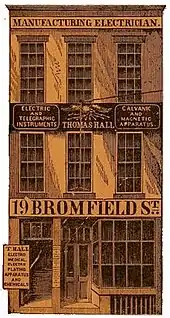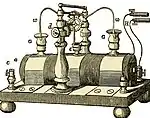Thomas Hall (inventor)
Thomas Hall was a nineteenth century American electricity experimenter, mechanic, physicist, electrical inventor and manufacturer. He worked with the inventor Daniel Davis for many years co-inventing electric and telegraph equipment. He later ran his own business manufacturing and selling electric components, electromagnetic devices and telegraph apparatus. He received many gold and silver awards for his innovations. One of his electricity experiments was a toy model size electric locomotive that got its power directly off the tracks it was running on, which was a new concept and technology at the time. He was mostly associated with Boston and the area.
Thomas Hall | |
|---|---|
.jpg.webp) circa 1880 | |
| Born | April 20, 1826 |
| Known for | Electrical instruments |
Early life
Thomas Hall was born in Norwich, England, on April 20, 1826. He was named after his father who was a physician and went to Boston in 1828 from England. Hall had five siblings, three brothers and two sisters. In 1833, Hall first went to the public school kept by Miss Miller at the corner of Dover and Washington streets. In 1834 Hall entered the Franklin School, a private institution. The teachers there were Richard Green Parker, Miss Marden, Miss Barry, Mrs Pierce and Mrs Bascomb. In 1836, Hall attended the East Street school. Later he attended Eliot School at the Jamaica Plain neighborhood where his father's practice was mainly situated.[1]

Mid life and career
Hall was indentured by his father to Daniel Davis the electrician in 1840 when he was 14 years old. Davis at the time was located at 11 Cornhill avenue and in 1844 moved his business to 528 Washington Street. Together they constructed the first telegraph devices for Samuel Morse in 1844. After that they made other telegraph related parts like sounders, keys, and registers. Hall was the first man in America to teach the skill of telegraphy. At the time he was involved in inventing the protective relay, lightning arrester, electric magneto and an electric railroad signal. Being a skillful electrical technician and mechanical engineer he constructed much of Dr. Charles Grafton Page's inventions.[2] Many of his inventions were used by the public and railroads for decades.[3]
Hall with George W. Palmer bought out Davis's business in 1848 and formed Palmer & Hall. In 1856 he bought out Palmer's interest and the business was then known as Thomas Hall / Magnetical & Telegraphic Instrument Maker.[4] That firm continued business until 1892 when Hall brought into the firm a son and the name became Thomas Hall & Son. Their place of business was 19 Bromfield Street in Boston. There they made all kinds of electromagnetic apparatus and school experimentation equipment for physics and chemistry classes.[5] They also made electric devices for medical use including Hall's New French Battery.[6]
Hall invented electrical mechanical apparatus while in business and became a well known manufacturer of these type apparatus in Boston.[7] One device was an electric stop on a paper-ruling machine and another was an electric valve used in milk creameries to keep the milk at a constant temperature for cream separation and processing butter. Another electrical mechanical device he invented was an electric recorder for measuring at a pumping station the water height or gas height at a reservoir. He also invented a life raft that took his name. The result of all his work has brought him a number of American gold and silver medals. In 1867 from the Paris Exposition he earned a medal for his electric railroad signal. Most of his work was experimental and costly. He was never able to made a large amount of money from his inventions. They did however bring him in acquaintance with many of the prominent inventors and businessmen of the electrical and scientific fields throughout America in the nineteenth century.[3]
Below are images of typical battery and electromagnetic apparatus for the electrical field manufactured and sold in 1861 by Hall from his catalogue of products .
 Coil and battery in box
Coil and battery in box
for family intertainment Double Helix coil and
Double Helix coil and
vibrating electrotome A coil with battery
A coil with battery
in rosewood box Compound electrotome
Compound electrotome
with clockwork addition
Electric locomotives
Hall at the age of 24 constructed a toy model experimental electric locomotive which took its electric power from the tracks.[8][9][10] The electricity came from two batteries that were located on the second story of the exhibit building about 200 feet away from the tracks.[11][12] This train set was shown in Palmer & Hall's 1850 catalogue.[13][14] The charged wheels of the locomotive, one side positive and the other side negative, were insulated from each other's side so there was no polarity short circuit. The tracks were straight and about 20 feet long.[15] It was arranged to automatically switch polarity on the battery current when it got to the end of the track and run in reverse returning to where it started.[12][16][17] Hall exhibited this model train with a reciprocating engine in 1851 at the Massachusetts Charitable Mechanics Fair in Faneuil Hall, Boston.[18] The tracks for the model train were connected to stationary batteries. This was the first time this technology had been done of electric current being supplied from the railroad tracks to the motor of the electric locomotive instead of onboard batteries.[19] It was the first instance of rolling contacts used from a stationary electric power source.[20] This was the first time an electric railway was made that operated by wheels or trolleys where it received its electric power from the tracks it was riding on.[12][21]

The main reason for this idea of having stationary batteries in one place away from the locomotive was so the batteries would not be damaged, which usually happened when the batteries were mounted in the moving vehicle. This toy electric train was sold as a scientific apparatus.[22] The electric power was furnished by two Grove battery cells that were wired directly to the rails the locomotive was riding on. The electric power to run the engine was picked up off the tracks through the steel wheels, with one track having the positive charge and the other track having the negative charge.[19] In 1860 he exhibited on a circular track in Quincy Hall in Boston an advanced version of this model train called the Volta that was constructed like a steam locomotive.[3] This time the direct current electric power was furnished from a dynamo generator instead of batteries and that machinery after the exhibition went to the physical laboratory at Harvard College.[12]
Hall made in 1852 for a Dr A. L. Henderson of Buffalo, New York, a model railroad train set complete with an electric locomotive, telegraph line, electric railroad signals and miniature depots. Scaled down toy figures operated the signals at each end of the telegraph line automatically.[13] This was the first instance of any electric railroad train being controlled by telegraph signals.[14] The practice was so common throughout the United States by 1888 it attracted little attention to talk about it. This showed how little some technology had changed in fifty years, as Hall conveyed the electrical current to his toy locomotive through several feet of rail using the rail as the electrical conductor from a power source yards away. Edison did basically the same thing some thirty years later in his historic electric railroad experiments at Menlo Park with a power source blocks away.[23] Most trolleys on the streets in the cities of the United States by 1910 were receiving their electrical power to operate from a distant power station miles away.[14]
Later life
Hall lived in Auburndale, Massachusetts, in the 1890s when he retired.[1] He lived with a son in Cincinnati after 1900.[3]
Personal life
Hall married Julia W Beals of Bath, Maine, in 1853. They had three boys. He was a mason belonging to the Fraternity Lodge of Newtonville Massachusetts, a member of the Massachusetts Charitable Mechanic Association, and a member of the Boston City Guards. He belonged to the Franklin School Association, Veteran Association of Mechanics Apprentices Library, and the Old School Boys Association.[1]
References
- Brayley 1894, p. 209.
- Brackett 1890, p. 40.
- Electrical World 1906, p. 852.
- Harvard University 2022, p. 1.
- "May yet Talk with Stars". The Boston Globe. Boston, Massachusetts. May 28, 1916. p. 60 – via Newspapers.com
 .
. - Hall 1880, pp. 2–99.
- Manning 2022, p. 1.
- Whipple 1889, p. 90.
- King 1962, p. 267.
- "Development of Electric Railways". The Independent Record. Helena, Montana. October 30, 1907. p. 4 – via Newspapers.com
 .
. - Railway Mechanic 1885, p. 22.
- "The Greenace Lectures". Boston Evening Transcript. Boston, Massachusetts. August 2, 1897. p. 6 – via Newspapers.com
 .
. - Martin 1892, p. 20.
- Dyer 1910, p. 101.
- Electrical Review 1885, p. 69.
- Luce 1886, p. 36.
- DePew 1895, p. 343.
- Dyer 2019, p. 65.
- "September 1 in History - First Electric Railway". The Oregon Daily Journal. Portland, Oregon. September 1, 1910. p. 8 – via Newspapers.com
 .
. The same year Thomas Hall of Boston built a small electric locomotive, called the Volta. The current was furnished by two Grove battery cells which were conducted to the rails, thence through the wheels of the locomotive to the motor This was the first instance of the current being supplied to the motor on a locomotive from a stationary source.
- "The Progress of Electricity". The Commercial Appeal. Memphis, Tennessee. February 10, 1901. p. 26 – via Newspapers.com
 .
. - Trevert 1892, p. 146.
- "The History of the Nineteenth Century Electricity". Washington Times. Washington, District of Columbia. February 10, 1901. p. 8 – via Newspapers.com
 .
. - Hungerford 1928, p. 86.
Sources
- Brackett, Cyrus Fogg (1890). Electricity in Daily Life. C. Scribner's sons. p. 40. OCLC 2403777.
- DePew, Chauncey Mitchell (1895). One Hundred Years American Commerce. D.O. Haynes. p. 343. OCLC 1195468396.
- Brayley, Arthur Wellington (1894). Schools & Schoolboys of Old Boston. L. P. Hager. p. 209. OCLC 680441827.
- Dyer, Thomas C. (2019). Edison, His Life and Inventions. Outlook Verlag. p. 65. ISBN 9783734058783.
- Harvard University (2022). "Thomas Hall fl. 1840-1875". Historical Scientific Instruments. Harvard University. Retrieved April 19, 2022.
- King, W. James (1962). Development of electrical technology in nineteenth century. Smithsonian Institute. OCLC 636802960.
- Luce, Robert (1886). Electric Railways & Electric Transmission. W.H. Harris & Company. p. 36. OCLC 11847293.
- Manning, Kenneth R. (2022). "Culture of Invention in Boston". Rutgers School of Sciences. Rutgers University. Retrieved April 22, 2022.
- Martin, Thomas C. (1892). The Electric Motor. W. J. Johnson.
- Electrical Review (1885). "Electrical Railways". The Telegraphic Journal and Electrical Review. 16: 65.
- Electrical World (1906). "Personal - Mr. Thomas Hall". Electrical World. McGraw-Hill. 47 (16): 852.
- Railway Mechanic (1885). "Development of Electricity as a Meter". Railway Master Mechanic. Simmons-Boardman Publishing Company. 8.
- Trevert, Edward (1892). Electric Railway Engineering. Bubier Publishing Company. p. 142. OCLC 22750915.
- Whipple, Fred H. (1889). The Electric Railway. The Lewis & Power Mfg Company. OCLC 913150527.
